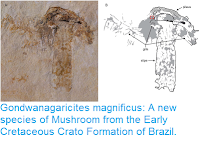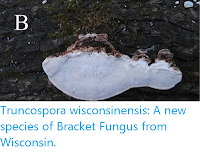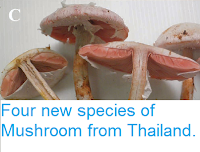Inky Cap Mushrooms, or Coprinoids, are saprophytic Fungi (Fungi that feed by breaking down decaying organic material) which produce Mushrooms with gills that liquify as they mature, releasing spores in a black 'ink' that aids dispersal. They were formerly all included in a single genus, Coprinus, until genetic analysis methods revealed that not all Inky Caps shared a common ancestor, resulting in many species being taken out and placed in three new genera, Coprinellus, Coprinopsis, and Parasola. To make matters worse, species tend to be both similar to one another and morpholgcally variable, so it is likely that the described list of species contains both hidden (cryptic) species that have not been recognised, and specimens of the same species described undr different names.
In a paper published in the journal Plant Systematics and Evolution on 28 April 2017, Błażej Gierczyk of the Faculty of Chemistry at Adam Mickiewicz University, Pamela Rodriguez-Flakus of the Laboratory of Molecular Analyses at the Władysław Szafer Institute of Botany of the Polish Academy of Sciences, Marcin Pietras of the Department of Plant Taxonomy and Nature Conservation at the University of Gdańsk, and the Laboratory of Symbiotic Associations at the Institute of Dendrology of the Polish Academy of Sciences, Mirosław Gryc of Ogrodniczki, Waldemar Czerniawski of Skawina, and Marcin Piątek of the Department of Mycology at the Władysław Szafer Institute of Botany of the Polish Academy of Sciences, describe a new species of Inky Cap Mushroom from Poland.
The new species is placed in the genus Coprinus,and given the specific name rugosomagnispora, meaning 'large, wrinkled spores', in reference to its distinctive spores, though it has been confirmed as a separtate species by genetic analysis. Coprinopsis rugosomagnispora forms small Mushrooms, with a cap at most 15 mm across, white in colour with gills that go from white to grey to black before liquifying. The species was found at two locations 450 km apart, in Podlaskie and Małopolska provinces, and is though likely to be present in other parts of Poland and probably other European countries. It was found growing on wet ground in both coniferous and mixed forests.
Basidiocarps of Coprinopsis rugosomagnispora from the Puszcza Knyszynska forest, northeast Poland: (a), (b) general view; (c) lamellae; (d), (e) young basidiocarps; (f) old specimen. Gierczyk et al. (2017).
See also...
Follow Sciency Thoughts on Facebook.







